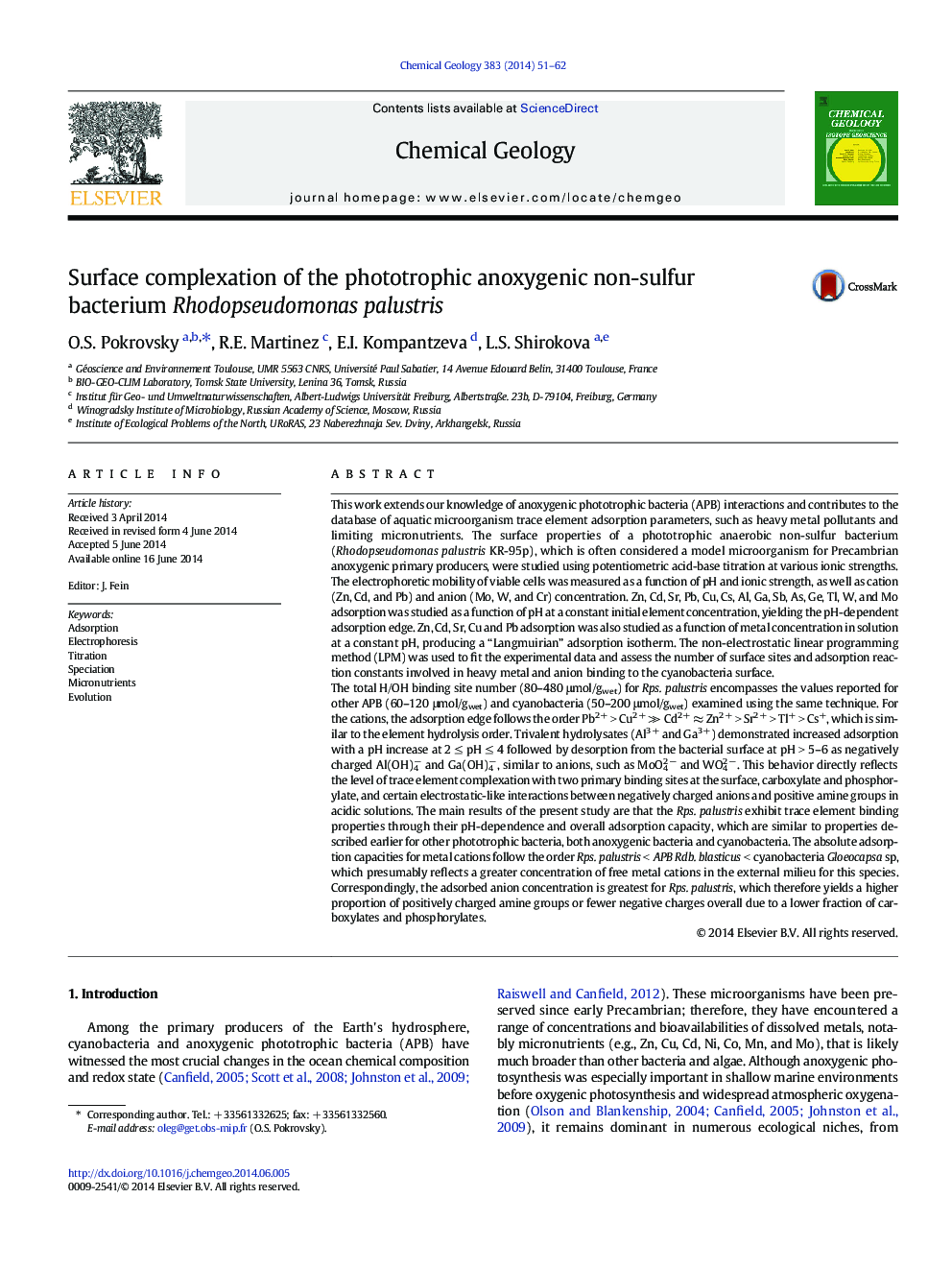| کد مقاله | کد نشریه | سال انتشار | مقاله انگلیسی | نسخه تمام متن |
|---|---|---|---|---|
| 4698677 | 1637589 | 2014 | 12 صفحه PDF | دانلود رایگان |

• Anoxygenic phototrophic bacteria (APB) were studied via multiple approaches.
• A combination of surface titration and electrophoresis revealed APB surface amphoteric properties
• Cations and anions adsorb at the APB surface following their physico-chemical properties
• Metal adsorption follows the order Pb2 + > Cu2 + ≫ Cd2 + ≈ Zn2 + > Sr2 + > Tl+ > Cs+
• This order is similar to element hydrolysis
This work extends our knowledge of anoxygenic phototrophic bacteria (APB) interactions and contributes to the database of aquatic microorganism trace element adsorption parameters, such as heavy metal pollutants and limiting micronutrients. The surface properties of a phototrophic anaerobic non-sulfur bacterium (Rhodopseudomonas palustris KR-95p), which is often considered a model microorganism for Precambrian anoxygenic primary producers, were studied using potentiometric acid-base titration at various ionic strengths. The electrophoretic mobility of viable cells was measured as a function of pH and ionic strength, as well as cation (Zn, Cd, and Pb) and anion (Mo, W, and Cr) concentration. Zn, Cd, Sr, Pb, Cu, Cs, Al, Ga, Sb, As, Ge, Tl, W, and Mo adsorption was studied as a function of pH at a constant initial element concentration, yielding the pH-dependent adsorption edge. Zn, Cd, Sr, Cu and Pb adsorption was also studied as a function of metal concentration in solution at a constant pH, producing a “Langmuirian” adsorption isotherm. The non-electrostatic linear programming method (LPM) was used to fit the experimental data and assess the number of surface sites and adsorption reaction constants involved in heavy metal and anion binding to the cyanobacteria surface.The total H/OH binding site number (80–480 μmol/gwet) for Rps. palustris encompasses the values reported for other APB (60–120 μmol/gwet) and cyanobacteria (50–200 μmol/gwet) examined using the same technique. For the cations, the adsorption edge follows the order Pb2 + > Cu2 + ≫ Cd2 + ≈ Zn2 + > Sr2 + > Tl+ > Cs+, which is similar to the element hydrolysis order. Trivalent hydrolysates (Al3 + and Ga3 +) demonstrated increased adsorption with a pH increase at 2 ≤ pH ≤ 4 followed by desorption from the bacterial surface at pH > 5–6 as negatively charged Al(OH)4− and Ga(OH)4−, similar to anions, such as MoO42 − and WO42 −. This behavior directly reflects the level of trace element complexation with two primary binding sites at the surface, carboxylate and phosphorylate, and certain electrostatic-like interactions between negatively charged anions and positive amine groups in acidic solutions. The main results of the present study are that the Rps. palustris exhibit trace element binding properties through their pH-dependence and overall adsorption capacity, which are similar to properties described earlier for other phototrophic bacteria, both anoxygenic bacteria and cyanobacteria. The absolute adsorption capacities for metal cations follow the order Rps. palustris < APB Rdb. blasticus < cyanobacteria Gloeocapsa sp, which presumably reflects a greater concentration of free metal cations in the external milieu for this species. Correspondingly, the adsorbed anion concentration is greatest for Rps. palustris, which therefore yields a higher proportion of positively charged amine groups or fewer negative charges overall due to a lower fraction of carboxylates and phosphorylates.
Figure optionsDownload as PowerPoint slide
Journal: Chemical Geology - Volume 383, 15 September 2014, Pages 51–62